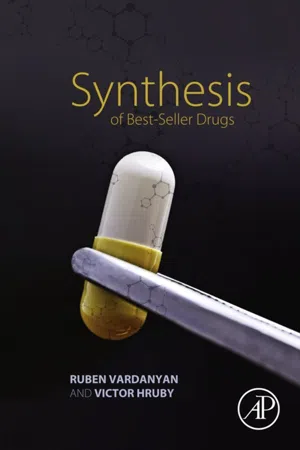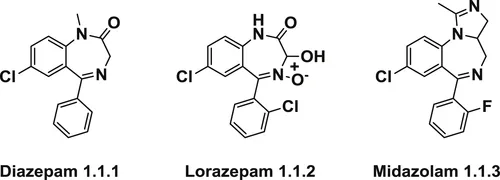
- 868 pages
- English
- ePUB (mobile friendly)
- Available on iOS & Android
eBook - ePub
Synthesis of Best-Seller Drugs
About this book
Synthesis of Best-Seller Drugs is a key reference guide for all those involved with the design, development, and use of the best-selling drugs. Designed for ease of use, this book provides detailed information on the most popular drugs, using a practical layout arranged according to drug type.
Each chapter reviews the main drugs in each of nearly 40 key therapeutic areas, also examining their classification, novel structural features, models of action, and synthesis. Of high interest to all those who work in the captivating areas of biologically active compounds and medicinal drug synthesis, in particular medicinal chemists, biochemists, and pharmacologists, the book aims to support current research efforts, while also encouraging future developments in this important field.
- Describes methods of synthesis, bioactivity and related drugs in key therapeutic areas
- Reviews the main drugs in each of nearly 40 key therapeutic areas, also examining their classification, novel structural features, models of action, and more
- Presents a practical layout designed for use as a quick reference tool by those working in drug design, development and implementation
Frequently asked questions
Yes, you can cancel anytime from the Subscription tab in your account settings on the Perlego website. Your subscription will stay active until the end of your current billing period. Learn how to cancel your subscription.
No, books cannot be downloaded as external files, such as PDFs, for use outside of Perlego. However, you can download books within the Perlego app for offline reading on mobile or tablet. Learn more here.
Perlego offers two plans: Essential and Complete
- Essential is ideal for learners and professionals who enjoy exploring a wide range of subjects. Access the Essential Library with 800,000+ trusted titles and best-sellers across business, personal growth, and the humanities. Includes unlimited reading time and Standard Read Aloud voice.
- Complete: Perfect for advanced learners and researchers needing full, unrestricted access. Unlock 1.4M+ books across hundreds of subjects, including academic and specialized titles. The Complete Plan also includes advanced features like Premium Read Aloud and Research Assistant.
We are an online textbook subscription service, where you can get access to an entire online library for less than the price of a single book per month. With over 1 million books across 1000+ topics, we’ve got you covered! Learn more here.
Look out for the read-aloud symbol on your next book to see if you can listen to it. The read-aloud tool reads text aloud for you, highlighting the text as it is being read. You can pause it, speed it up and slow it down. Learn more here.
Yes! You can use the Perlego app on both iOS or Android devices to read anytime, anywhere — even offline. Perfect for commutes or when you’re on the go.
Please note we cannot support devices running on iOS 13 and Android 7 or earlier. Learn more about using the app.
Please note we cannot support devices running on iOS 13 and Android 7 or earlier. Learn more about using the app.
Yes, you can access Synthesis of Best-Seller Drugs by Ruben Vardanyan,Victor Hruby in PDF and/or ePUB format, as well as other popular books in Medicine & Pharmacology. We have over one million books available in our catalogue for you to explore.
Information
Chapter 1
General Anesthetics
Abstract
This chapter discusses those drugs that are used in general anesthesia, which is the state of controlled, reversible unconsciousness and loss of protective reflexes, controlled level of nervous system suppression to allow adequate surgical access, obstetric, and diagnostic procedures to be completed painlessly.
General anesthetic pharmacology is unique because so many types of molecules possess this activity, including, haloalkanes, ethers, barbiturates, quaternary ammonium salts, steroids, simple gases, and other organic compounds. General anesthetics produce a widespread neurodepression in the central nervous system by enhancing inhibitory neurotransmission and reducing excitatory neurotransmission.
Keywords
General anesthetics; Tranquilizers; Central nervous system depressants (barbiturates and hypnotic agents); Opioid analgesics; Ketamine; Muscle relaxants; Reversible acetylcholinesterase inhibitors; Inhalation anestheticsThe use of inhaled ether for surgical anesthesia was first demonstrated in 1846. Since then, the development of new safe anesthetics has contributed greatly to the advancement of surgery and other invasive procedures.
General anesthesia is the state of controlled, reversible unconsciousness and loss of protective reflexes, controlled level of nervous system suppression to allow adequate surgical access, obstetric, and diagnostic procedures to be completed painlessly. The patient receives medications for amnesia, analgesia, muscle paralysis, and sedation. Anesthesia includes the following components: analgesia (absence of pain), amnesia (absence of memory), suppression of reflexes such as bradycardia, laryngospasm, and loss of skeletal muscle tonicity.
In medical practice, general anesthesia is a complex procedure involving: preanesthetic assessment, administration of general anaesthetic drugs, cardiorespiratory monitoring, analgesia, airway management, and fluid management.
In a typical clinical procedure, the patient is premedicated with a sedative intended to relieve anxiety and facilitate the induction of anesthesia itself. For this purpose it is accepted to use tranquilizers, such as diazepam, lorazepam, or midazolam, or a central nervous system depressant-barbiturate such as thiopental, methohexital, or the hypnotic agent propofol. Sedation is followed by intravenous injection of an opioid analgesic such as morphine, fentanyl, alfentanil, or ketamine, which has a wide range of effects in humans, including analgesia and anesthesia. In addition, a nondepolarizing curare-like derivative like vecuronium or d-tubocurarine, or a depolarizing drug such as succinylcholine, is administered to induce muscle paralysis. After connection to artificial respiration, general anesthesia is maintained by a mixture of oxygen and nitrous oxide, often in combination with a volatile agent such as halothane, enflurane, or isoflurane. At the conclusion of the surgery, muscle relaxation is reversed by neostigmine or other anticholinesterase, and normal breathing is restored.
The ideal general anesthesia must include the aforementioned characteristics, as well as have a wide therapeutic index and no significant side effects.
The underlying neurocellular mechanisms by which the state of general anesthesia is achieved are only just beginning to be understood.
Components of general anesthesia formally are divided into two groups: noninhalation, (barbiturates, ketamine, and etomidate), and inhalation (halothane, enflurane, isoflurane, desflurane and nitrous oxide). Since the publication of our first book [1] in 2006 where the synthesis of all above mentioned drugs are described, no novel entities that address fundamentally new general anesthesia approaches have entered the clinic. That is the reason we limit discussion to the structural formulas of anesthetic agents in current clinical use.
1.1. Noninhalation Components for General Anesthesia
Tranquilizers
Benzodiazepines—diazepam (1.1.1), lorazepam (1.1.2), and midazolam (1.1.3)—which have anxiolytic, sedative, and anticonvulsant effects, and cause amnesia and muscle relaxation, are frequently used to relieve patient’s anxiety during anesthesia. (Fig. 1.1.)

Fig. 1.1 Benzodiazepines used during anesthesia.
Central Nervous System Depressants (Barbiturates and Hypnotic Agents)
Two barbiturates primarily used in surgical practice are thiopental (1.1.4) and methohexital (1.1.5). Barbiturates are hypnotics, and at therapeutic doses have a very weak analgesic and muscle relaxant effect. Intravenous injection of a therapeutic dose of propofol (1.1.6) produces hypnosis rapidly with minimal excitation, usually within 40 seconds from the start of an injection. Etomidate (1.1.7) classified as a sedative hypnotic drug because of the quick loss of consciousness upon intravenous administration. It has an anticonvulsant activity and does not display analgesic characteristics. Duration of its action depends on the administered dose. (Fig. 1.2.)

Fig. 1.2 Barbiturates and hypnotic agents used during anesthesia.

Fig. 1.3 Opioid analgesics used during anesthesia.
Opioid Analgesics
Opioid analgesics, in particular morphine (1.1.8), fentanyl (1.1.9), alfentanil (1.1.10), and sufentanil (1.1.11), are widely used in the practice of anesthesiology as adjuncts. Recently, remifentanil (1.1.12) became popular for the mainten...
Table of contents
- Cover image
- Title page
- Table of Contents
- Copyright
- Dedication
- Preface
- Chapter 1. General Anesthetics
- Chapter 2. Local Anesthetics
- Chapter 3. Analgesics
- Chapter 4. Soporific Agents (Hypnotics and Sedative Drugs)
- Chapter 5. Anxiolytics (Tranquilizers)
- Chapter 6. Antipsychotics
- Chapter 7. Antidepressants
- Chapter 8. Central Nervous System Stimulants
- Chapter 9. Antiepileptic Drugs
- Chapter 10. Antiparkinsonian Drugs
- Chapter 11. Adrenergic (Sympathomimetic) Drugs
- Chapter 12. Adrenoblockers
- Chapter 13. Cholinomimetics
- Chapter 14. Anticholinergic Drugs
- Chapter 15. Centrally Acting Skeletal Muscle Relaxants
- Chapter 16. Antihistamine Drugs
- Chapter 17. Cardiotonic Inotropic Drugs
- Chapter 18. Antiarrhythmic Drugs
- Chapter 19. Antianginal Drugs
- Chapter 20. Hypolipidemic and Antihyperlipidemic Drugs
- Chapter 21. Diuretics
- Chapter 22. Antihypertensive Drugs
- Chapter 23. Drugs for Treating Respiratory System Diseases
- Chapter 24. Antithrombotic Drugs (Anticoagulants, Antiplatelets, and Thrombolytics)
- Chapter 25. Thyroid and Antithyroid Drugs
- Chapter 26. Hyperglycemic and Hypoglycemic Drugs
- Chapter 27. Steroid Hormones
- Chapter 28. Antineoplastic Agents
- Chapter 29. Immunopharmacological Drugs
- Chapter 30. Antibiotics
- Chapter 31. Antibacterial Drugs
- Chapter 32. Antimicobacterial Drugs
- Chapter 33. Antifungal Drugs
- Chapter 34. Antiviral Drugs
- Chapter 35. Drugs for Treating Protozoan Infections
- Chapter 36. Anthelmintics
- Chapter 37. Proton Pump Inhibitors
- Chapter 38. Drugs for Treatment of Erectile Dysfunction
- Drugs Index
- Subject Index